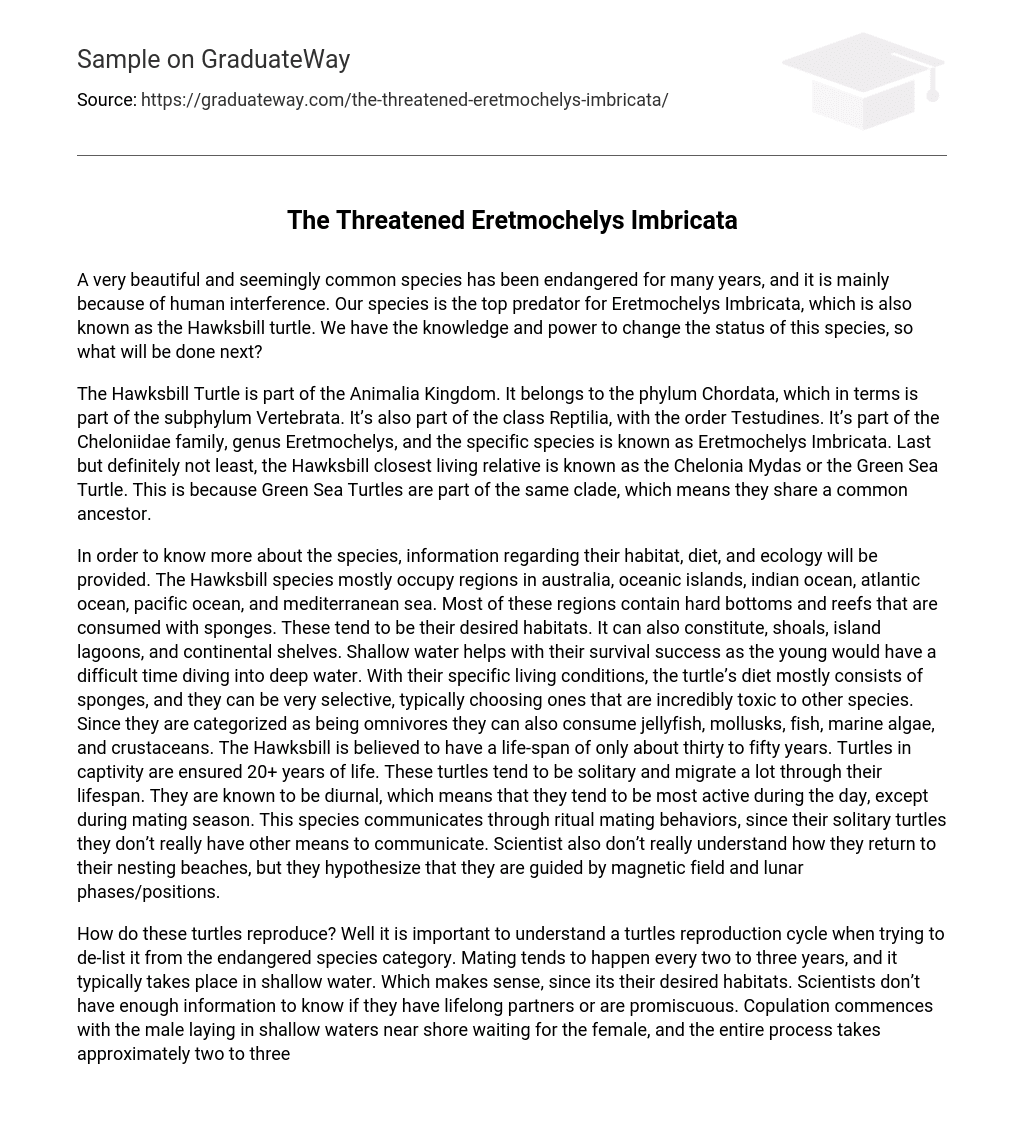A very beautiful and seemingly common species has been endangered for many years, and it is mainly because of human interference. Our species is the top predator for Eretmochelys Imbricata, which is also known as the Hawksbill turtle. We have the knowledge and power to change the status of this species, so what will be done next?
The Hawksbill Turtle is part of the Animalia Kingdom. It belongs to the phylum Chordata, which in terms is part of the subphylum Vertebrata. It’s also part of the class Reptilia, with the order Testudines. It’s part of the Cheloniidae family, genus Eretmochelys, and the specific species is known as Eretmochelys Imbricata. Last but definitely not least, the Hawksbill closest living relative is known as the Chelonia Mydas or the Green Sea Turtle. This is because Green Sea Turtles are part of the same clade, which means they share a common ancestor.
In order to know more about the species, information regarding their habitat, diet, and ecology will be provided. The Hawksbill species mostly occupy regions in australia, oceanic islands, indian ocean, atlantic ocean, pacific ocean, and mediterranean sea. Most of these regions contain hard bottoms and reefs that are consumed with sponges. These tend to be their desired habitats. It can also constitute, shoals, island lagoons, and continental shelves. Shallow water helps with their survival success as the young would have a difficult time diving into deep water. With their specific living conditions, the turtle’s diet mostly consists of sponges, and they can be very selective, typically choosing ones that are incredibly toxic to other species. Since they are categorized as being omnivores they can also consume jellyfish, mollusks, fish, marine algae, and crustaceans. The Hawksbill is believed to have a life-span of only about thirty to fifty years. Turtles in captivity are ensured 20+ years of life. These turtles tend to be solitary and migrate a lot through their lifespan. They are known to be diurnal, which means that they tend to be most active during the day, except during mating season. This species communicates through ritual mating behaviors, since their solitary turtles they don’t really have other means to communicate. Scientist also don’t really understand how they return to their nesting beaches, but they hypothesize that they are guided by magnetic field and lunar phases/positions.
How do these turtles reproduce? Well it is important to understand a turtles reproduction cycle when trying to de-list it from the endangered species category. Mating tends to happen every two to three years, and it typically takes place in shallow water. Which makes sense, since its their desired habitats. Scientists don’t have enough information to know if they have lifelong partners or are promiscuous. Copulation commences with the male laying in shallow waters near shore waiting for the female, and the entire process takes approximately two to three hours. Soon after the turtles arise from the sea and look for a place to lay their eggs. Once they have found the perfect spot, they dig a hole and lay the eggs. Finally, they disguise their eggs to prevent predation of eggs. Breeding season is typically between July and October and it can result in an average of up to 140 offspring. Females reach their sexual maturity at age three, and they tend to lay three clutches. Each at an interval of thirteen to fifteen days. Overall, reproduction is pretty similar to many sea turtle and there is of course no parental involvement.
Evolution has allowed these creatures to obtain a hard shell that allows for protection from certain predators. The most common ones being humans, sharks, crocodiles, and octopi. Their nests can also be destroyed by terrestrial predators like dogs, raccoons and rats. However, the most dangerous moment of their lives is during their journey to the water as young. This is where gulls and large crabs compete to end the lives of baby turtles, a life that had just begun. Natural predation is obviously necessary in order to keep the ecosystem on track. However, we are drifting way too far from natural predation, without realizing how important these turtles are to their ecosystems. These turtles feed on sponges in order to prevent overpopulation. This allows for more space settlement and flourishment of other species.





